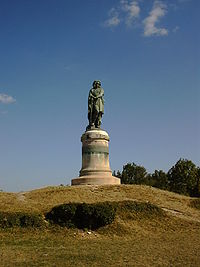
Vercingetorix Memorial in Alesia (Alise-Sainte-Reine)

The fortifications built by Caesar in Alesia
Inset: cross shows location of Alesia in Gaul (modern France). The circle shows the weakness in the north-western section of the fortifications
Alesia was the capital of the Mandubii, one of the Gallic tribes allied with the Aedui, and after Julius Caesar's conquest a Roman town (oppidum) in Gaul. There have been archeological excavations since the time of Napoléon III in Alise-Sainte-Reine in Côte d'Or near Dijon, which have claimed that the historical Alesia is located there. New discoveries are constantly being made about this Gallo-Roman settlement on the plateau of Mont-Auxois. As a result of the latest excavation, a find was presented to the museum there with the inscription: IN ALISIIA, which finally dispelled the doubts of some archaeologists on the town's identity.
Earlier theories[]
There have been other theories about Alesia's location that claimed it was in Franche-Comté or around Salins-les-Bains in Jura. In the 1960s, a French archaeologist, Andre Berthier, proposed that the location of Alesia is at Chaux-des-Crotenay in Franche-Comté, at the gate of the Jura mountains - a place that better suits the descriptions in Caesar's Gallic Wars - and indeed, Roman fortifications have been found at that site. The uncertainty surrounding Alesia's location is humorously parodied in the Asterix volume Asterix and the Chieftain's Shield, in which, in this case because of Gaulish pride, characters repeatedly deny that they know its location ("I don't know where Alesia is! No one knows where Alesia is!").
Caesar's battle[]
In 52 BC, Alesia was the site of the decisive battle between the Romans under Julius Caesar and the Gauls under Vercingetorix. The battle's outcome determined the fate of all of Gaul: in winning the battle, the Romans won both the Gallic War and dominion over Gaul. The fight is described in detail by Caesar in his Commentarii de Bello Gallico (Book 7, 68-69). The latest analysis at Alise-Sainte-Reine is said to corroborate the described siege in detail. The enormous measures taken during the battle were impressive: in only six weeks, Caesar's troops built a ring of fortifications 15 km long (circumvallation) around Alesia and an additional ring 21 km long (contravallation) around that to stop reinforcements (around 250,000 men according to Caesar) from reaching the Gauls. The remains of rings said to match these descriptions have been identified by archaeologists using aerial photography.
References[]
- The information in this article is based on a translation of its German equivalent.
- The Siege of Alesia
See also[]
Coordinates: 47°32′14″N 4°30′01″E / 47.53722°N 4.50028°E
The original article can be found at Alesia (city) and the edit history here.